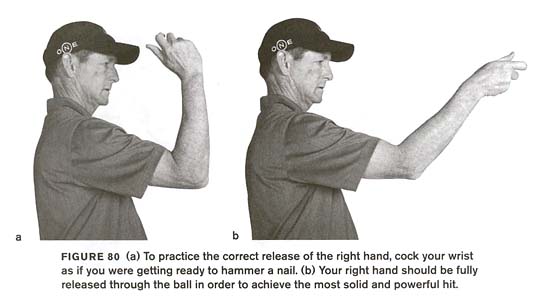I can't improve anything, I'll just give my "2 Cents Worth"
This is a very good post, even if you're not "CJ". jk I can't improve anything, I'll give my "2 Cents Worth," because I believe you hit on some truly vital and essential points.
jk I can't improve anything, I'll give my "2 Cents Worth," because I believe you hit on some truly vital and essential points.
Fly fishing or casting in general is something I use as a reference as well. I also use the analogy of using a bullwhip, or whipping a wet towel. In every case the forward motion does have to start slowly or you use the potential energy. It's also important not to move the body forward, especially on the break, or your potential will diminish.
Another key to synchronising this motion is to make sure to accelerate your hand/wrist/finger EXACTLY at the moment of contact. I believe relates to the timing factor you mentioned. It's human nature to try to rush the first part of the stroke and even after many years I still have to concentrate on this in practice. I have several ways to teach this, however, your post gives a outstanding example of what outcome to strive for.
I have to give credit where credit is due, your post really hit home, and I encourage everyone to read, and re read the fishing analogy, it's spot on imho.
Here's a picture that I've posted several times because once someone understands that the pool stroke is like a fishing, golfing, or hammer motion they can improve very rapidly. The stoke and the effectiveness of the motion is a huge part of playing well.

This is a very good post, even if you're not "CJ".
Fly fishing or casting in general is something I use as a reference as well. I also use the analogy of using a bullwhip, or whipping a wet towel. In every case the forward motion does have to start slowly or you use the potential energy. It's also important not to move the body forward, especially on the break, or your potential will diminish.
Another key to synchronising this motion is to make sure to accelerate your hand/wrist/finger EXACTLY at the moment of contact. I believe relates to the timing factor you mentioned. It's human nature to try to rush the first part of the stroke and even after many years I still have to concentrate on this in practice. I have several ways to teach this, however, your post gives a outstanding example of what outcome to strive for.
I have to give credit where credit is due, your post really hit home, and I encourage everyone to read, and re read the fishing analogy, it's spot on imho.
Here's a picture that I've posted several times because once someone understands that the pool stroke is like a fishing, golfing, or hammer motion they can improve very rapidly. The stoke and the effectiveness of the motion is a huge part of playing well.

Sloppy Pockets;5026900[B said:I'm not CJ but I'll tell you what I do to get true acceleration throughout the stroke. I pause ever so slightly at the end of the backstroke and then deliberately start the forward stroke slowly. Watch most top snooker players and you will see they do the same thing.
I used to be a fly casting instructor, and the hardest thing I found to teach is the timing involved in smooth acceleration. Flaws in casting stroke timing have a much more profound effect on a fly cast than they do on a pool stroke. Even with a decelerating cue stroke you will probably still make the ball. You may get crap action on the CB, but the ball will go in if you deliver a straight stroke along the proper shot line.
If you accelerate too quickly or erratically with a fly cast you will put a bend in the rod when and where you don't want it. This will force the rod tip downward, bringing the line along with it, and creating what is called a "tailing loop" (the fly drops below the plane of the unrolling line). This will kill the cast in mid air, and will likely tie an overhand knot right in the middle of your expensive fly line.
What I have seen over and over (and particularly with men) is that the caster rushes the stroke at the beginning and runs out of gas at the end. I used to tell guys to thrust their rod tip up and back at the end of the backstroke, and to wait until they felt the pull of the line, then to begin the forward stroke with a dragging motion before applying full power. This usually gave them the slow start requiring for continuous acceleration and a smooth, straight cast.
I've transferred that "dragging" feeling to the beginning of my pool stroke and it has really done wonders for me. The cue gets through the ball in a much more convincing way now, and the action on the CB is greater in spite of feeling like I am using less force. Well, I am using less force, but the power delivery is greater because the cue never stops increasing in speed throughout the stroke. And less force means a straighter stoke in most cases, so the CB goes where I want it to go.
As an aside, I've noticed in the hundreds of people that I've taught to fly cast that this problem occurs almost exclusively with male casters. Females casters are mostly naturals in this regard. This may be because woman lack the upper body strength of men, and learn to use proper timing at an early age to accomplish what we machos try to accomplish with brute strength. Therefore, women in both sports often have more elegant stroke timing than the men do.
